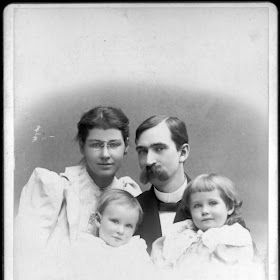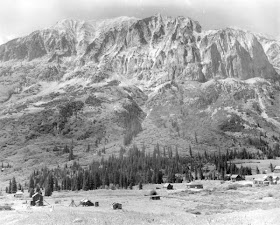She always vanished the moment someone on
the train recognized and called her by name
By Rob Carrigan, robcarrigan1@gmail.com
The first time I heard the
story of Emma Mentzer was in Brian Tobin’s history class, as a junior in high
school. In between his rants about “screaming Arab regulars,” Tobin was famous
for dramatic accounts of seemingly minor details in life and times of eras
past. They provided texture and color for history that I have enjoyed to this
day. He told personal stories of
fishing with hand grenades as a U.S. Marine in Viet Nam, (toss a grenade in the
lagoon, jump back, then gather the fish) and strange and terrible tales of fear
and loathing in the heart of American depravity.
But the yarn of Emma’s
plight carried special meaning because it was right up the railroad there in
Telluride – if only the railroad was still around.
By all accounts, there was
no questioning that Emma Mentzer was a fine-looking woman. Variously described
as “a handsome woman and very devoted to her husband,” and “pretty woman from
Chicago who, by everyone’s estimation had married well when she wed a young
physician named O.F. Mentzer,” her story has captured yarn weavers attention
for more than a hundred years.
Trouble is, figuring out
what is her story.
Swirling around in the snow
and thin air up there are several fantastic versions and separating the gold
from the overburden is an arduous task.
The various versions twist and turn different ways, even to point of
indentifying who she was, and what was her name. Was it Emma, or “Essie?” Was
she patron of Chicago society, or former Madam at a house of ill repute? All
are questions that have been pondered for a century now, hairs that have been
split and examined, but without definitive answer. I’m not sure I am up for
answering them either. So, I will tell you what I know.
Oscar F. Mentzer traveled
from his native Sweden to the United States in 1881 and by 1890, he had set up
a physician’s practice on Larimer Street in Denver.
“He enjoyed a reputation as
a skilled surgeon and built up a large practice worth reportedly $15,000 per
year,” according to Carol Turner, in her book “Notorious Telluride: Wicked
Tales from San Miguel County.”
“Mentzer was also known as a
charitable, kind doctor who treated many poor patients without charge.”
Oscar and Emma (formerly Monroe)
had met when they were both guests at the Hotel Albert in Denver and were married
in Colorado Springs in July of 1894.
“Unfortunately, despite his
happy circumstances, thirty-year-old Dr. Mentzer was and alcoholic,” writes
Turner. “His drinking soon began to interfere with his practice. He missed days
in the office and patients left his care, seeking a more sober physician. Emma
Mentzer left her husband and returned to Chicago, where she reportedly divorced
him.”
According to Turner’s
account, the good doctor announced to his friends that he was getting away from
the temptations of the city and moving to Telluride to reform and set up a new
practice.
He did so, and after a year
in the roaring camp, as Turner describes, he was generally respected around the
camp as a “very able surgeon.”
“However there were ‘some
incidents where he committed acts that did not meet with the general approval…
and he was feared to a certain extent, especially by female patients.’”
In late 1897, Oscar renewed
contact with his ex-wife. Reports in the Telluride papers said that she told
him that she was “sick and starving and imposed upon and if she didn’t have
him, she would have to starve to death.”
The doctor began sending
money to his former wife in Chicago and continued throughout 1898, accounting
for more $900 that year (which was a tidy sum in those days, equating to
substantial annual salary) as revealed in records later. All this time, he
begged his wife to return and promised his complete reform. In July, she
apparently agreed to meet him in Denver and they renewed their marriage, and
returned to Telluride in early August.
On the condition that he
stay sober apparently, but that was not to be.
Oscar’s former partner,
pharmacist S.A. Gross told the Telluride Journal later, “Mentzer was here six
weeks or so ago. He wanted to come back with me again but I told him no. He was
too far gone. He looked seedy from drinking so much. He said he was going to
stop drinking for good, but I could see that he never again would be the man he
had been, so I wouldn’t have him.”
Upon the Mentzer’s return to
Telluride, Emma’s brother Will Monroe and his wife, also moved to the camp with
intentions of going to work at the Bessie Mill as engineer. They stayed with
the Mentzers.
“During the first week in
October, Mentzer visited Tompkins Hardware Company in Telluride and purchased a
.32 caliber Iver Johnson pistol. He told the salesman he needed protection
against “dogs and holdups” when he traveled at night to places like Sawpit. The
salesman insisted that Doc Mentzer was perfectly sober when he purchased the
weapon or he would not have sold it to him,” says Turner.
Will Munroe, Emma’s brother,
told the following account of the night of Oct. 7, in testimony before the
court, during Oscar Mentzer’s trial for the murder of Emma Mentzer.
The Monroes and Mentzer’s
had a pleasant evening together and the Doctor was jovial and smiling. About
9:30 in the evening, Emma suddenly called to her brother from another room.
Arriving right away, he heard a scream and a shot. As he entered the room, the
doctor turned to him, smoking gun in hand. The two wrestled for control of the
pistol and Will Munroe was able to remove the gun and toss it to his wife who
had arrived according to his testimony. She in turn, threw it out in the yard.
The two men “both splendid specimens of physical manhood” continued the fray
until Will Monroe got the upper hand and knocked the doctor unconscious. He
then reportedly dragged him out to the porch and threw him in heap.
Only then did he return to
the house and discover his sister had been shot in the temple. Emma died from
her wound about half hour later, according to what Will told police. When they
arrived, the doctor was still unconscious in a heap on the porch. He remained
so even after they carted him off to the sheriff’s office as was deposited on a
cot there.
The next issue, the San
Miguel Examiner lamented over the death of Emma Mentzer.
“Mrs. Mentzer was a most
charming and amiable woman and possessed the traits that made her lovable to
all, and her sad fate brings great sorrow to her relatives and the community
alike.”
Meanwhile, it became obvious
to the authorities finally that the Doctor was suffering from a serious head
injury. The two doctors called, Hall and Clark, were unable to revive the man
and determined that they must trepan his skull, or drill a hole to relieve
pressure on the brain. The procedure seemed to have worked as the doctor, with
additional help from another inmate, pulled through.
“Three weeks after the
shooting, Mentzer had his preliminary hearing,” writes Carol Turner. “The only
witnesses, Will Monroe and his wife, gave mixed and contradictory testimony
during the hearing, and observers began to express doubts about their
reliability and respectability.”
There was rampant
speculation that these witnesses, may in fact, hustle out of town in the middle
of the night.
In the doctor’s version of
the story, he had no intention of shooting his wife and the gun went off
accidently in the struggle with Monroe.
The verdict was delivered to
a packed courtroom early in the day on December 5, 1898 finding Oscar Mentzer
guilty of second-degree murder, with a recommendation for leniency. He was
sentenced to 20 years.
According to Turner, “After
the trial, public opinion swung sharply in Mentzer’s favor when detail emerged
about the questionable character of the Monroes, including Emma.
(The same day the jury
reached a verdict,) Will Monroe’s real wife arrived in town, having traveled
all the way from Illinois. It turned out she and her attorneys had been
scouring the country looking for Monroe, and the headlines about the shooting
had revealed his whereabouts.”
“Mrs. Monroe said her
husband had beaten her and strangled her on many occasions. Finally he took her
and the children to her sister’s house in Chicago and left them there. After
many weeks without word, she hired detectives to hunt them down. They found
them in a Chicago bordello with the woman he now claimed was his wife. She
stated further that Emma Mentzer was the “landlady” of the Chicago bordello,
and at that time was in court facing charges of theft. The Monroes took off and
that was the last she knew of them until she read in the papers of the shooting
in Telluride.
According to the Telluride
Journal at the time:
“The whole history of her (Mrs.
Monroe’s) life with Monroe show him to be a most despicable character, and it
is a little remarkable that the proven bigamists and self confessed perjurer
should be allowed to quietly slip away without punishment. His sister, whose
evil influence had much to do with his downfall and outrageous treatment of his
wife and children, and their final abandonment, is in her grave, sent there by
a bullet fired by the man she had driven into a frenzy.”
By that time, Will Munroe
and his “other wife” had disappeared from Telluride. There was talk of a new
trial but Oscar Mentzer had already began serving his time in Canon City.
His medical training
apparently had a role in securing a spot in the prison dispensary. Injuries
sustained from the beating from Monroe made it difficult to sleep and he took
chloral hydrate to help. Twenty months into his sentence, with his friends and
attorney working on a possible pardon, he appeared at the prison kitchen asking
for coffee but before he could take a sip, he fell to the floor and died, cause
attributed to an overdose of chloral hydrate. He was 36.
But here is where some
versions of the story take on a life of their own.
Tales of “Essie” (instead of
Emma) Mentzer being sighted on the Rio Grande Southern railroad became a
standard. In most such yarns, the Doctor was a Jekyll an Hyde sort of fellow
with not only binge drinking problem but a maniacal drug habit as well. According
to the stories, in front of many witnesses, a beautiful woman would appear as
real as you or I. People on the train would offer her sympathy and help, but
she was inconsolable and frantic, hysterically repeating, “He’s almost here. I
have to go.” Then disappear into the thin mountain air, right in front of
everybody.
In one version of the story
by Dan Asfar appearing in his book, Ghost Stories of Colorado, “with every
successive mile, she grew more anxious, feeling the presence of her homicidal
husband get stronger and stronger. She always vanished the moment someone on
the train recognized and called her by name. If that didn’t happen before she
was 10 miles out of town, she would just vanish on her own, unable to deal with
the dread of an unseen husband’s approach any longer. Those 10 miles were as
far out of Telluride as Essie Mentzer was ever able to get.”
One question from me only, “Do
we call the ghost Essie, or Emma?”
I suppose we should inquire
as well, if she ever went fishing with hand grenades?
###
























